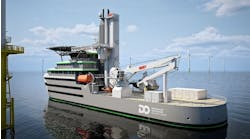Across-industry group is working on new guidelines for offshore supply vessels (OSVs) operating in dynamic positioning mode. The latest survey by the International Marine Contractors Association (IMCA) suggests that station-keeping incidents are in general on the decline in the offshore sector. However, there are concerns, particularly from the major oil companies, over the experience of some OSVs and their crews with respect to certain DP tasks.
When IMCA started its annual surveys in the early 1990s, dynamic positioning was employed only by the most sophisticated offshore construction vessels, says technical adviser Philip Wiggs.
“Until around five years ago, there was no real need for it on supply vessels,” Wiggs says. “But as the equipment became more widely available, and less expensive, shipyards began providing many of the new vessels with some form of DP. This ranged from a full-blown DP system to a super-joystick type - there was no consistency.”
During the last decade, the International Maritime Organisation (IMO) did produce general guidelines for DP operations (MSC Circular 645 and 738), with input from IMCA. According to Wiggs, these defined operating requirements for the three different classes of dynamic positioning and for training and experience of key DP personnel.
“Some OSVs come out of yards with Class 1 or 2 notation,” he explains, “allowing them to be chartered for a multi-purpose role, not just platform support. Others only have sub-Class 1 capability. The problem lies in the fact that some OSV operators are not used to working with DP, and platform operators are concerned about the potential risks arising from these vessels in DP mode being stationed alongside their installations.”
IMCA is coordinating the new initiative. The emerging cross-industry document is currently titled The International Guidelines for the Safe Operation of Dynamically Positioned Offshore Supply Vessels. The 40-strong working group comprises a broad selection of industry representatives, mainly from Europe, the Americas and the Far East. Participants range from major oil companies to ship-owners, chartering companies, drilling rig and pipelay contractors, and other trade groups and organizations, including the International Supply Vessels Operators Association. Their feedback on the first draft documents, generated last year, led to the amendments incorporated in the recent third draft, particularly on issues such as competency and risk assessment.
“Probably the main feeling coming through from the supply boat operators,” Wiggs adds, “was that guidelines on use of this technology have in general been too complex, or could develop into an added burden. Our intent is to provide a practical guidance that can make operations safer, more efficient and effectively ease rather than increase any burden.”
The guidance also takes into account the fact that in emergency situations, supply boats can switch quickly from DP to manual mode to effect a quick getaway from an offshore installation. “Diving support vessels, for example, can’t do this because they must protect their divers. So it isn’t necessary for OSV s to follow all the strict guidance that applies to DSVs.”
Draft procedures
Section 2 of the currently drafted document addresses the application of existing international rules and guidelines, and reviews requirements of the main classification for societies for DP class notations. It also informs OSV owners as to required certification and documentation, and gives guidance on manning, appropriate levels of training, skills and experience.
Section 3 gives guidance on procedures and a risk management approach, designed to cut the risk of a loss of position. Other issues covered include DP incident reporting. A reference list of procedural checks is provided, some examples of which are:
• Arrival checks before the vessel comes within 500 m of the installation, to ensure satisfactory operation of the DP system, including thrusters, power generation, automatic DP and joystick/manual controls
• Close proximity DP time at the offshore location to be kept to a minimum, i.e. only during actual supply operations
• Carefully selected separation distance, taking into account combined movements of the vessel and the unit being supplied, especially in cases where the latter (spar buoy, FPSO, TLP or pipelayer) is not fixed in position
• Continuous monitoring of environment, i.e. wind, current, sea and swell, to establish potential influence on position keeping
• Critical excursion limit should not exceed half the allowable separation distance between the vessel and installation
• Pre-defined power/thrusters limits for DP class 2 or 3 vessels, sufficient to maintain position after a worst-case failure
• Measures should be adopted to maintain appropriate draft and trim at all times, if necessary taking in water ballast: a shallower draft or change of trim can degrade some thrusters’ efficiency, in turn impacting station keeping and thruster redundancy.
Depending on agreement from the working group, Wiggs aims to submit a final draft of the guidelines to the industry and the IMO by November.•
For more information contact [email protected], tel. +44 207 824 5520.




